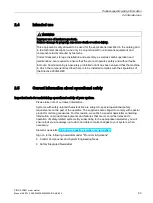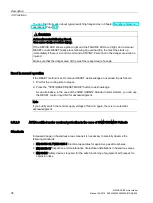
Description
3.5 Functions
SIRIUS 3RM1 motor starter
Manual, 06/2016, A5E0345285095020A/RS-AE/005
37
For exact values, see the curve in Chapter "Overload protection/device protection
characteristic (Page 145)." Some values are provided as examples from this curve in the
table.
Table 3- 5
Tripping times for tripping due to detected asymmetry
Maximum current in one of the 3 phases with reference to
the set rated current [%]
Tripping time [s]
86
132
90
77
100
50
120
32
The asymmetry detection is not active for setting value 10 A for resistive loads; in this case
the overload trip occurs according to the table Table 9-1 Tripping for resistive loads at a
setting value of 10 A (Page 147)
3.5.2.5
Thermal calculation method (motor memory module)
Principle of operation
The electronics continuously calculate a model of the thermal load on the motor dependent
on the operating time and the current load. The motor memory module charges when the
motor is switched on. The motor memory module discharges after the motor is switched off.
Following an overload tripping operation, the motor memory module is fully discharged after
approximately three minutes. You must wait for this cooling time to elapse before you can
acknowledge the fault. If the control supply voltage fails, the 3RM1 motor starter stores the
remaining cooling time. When the control supply voltage is restored, the remaining cooling
time elapses before the motor can be switched on again.
If you initiate a restart within a very short time after switching off the motor, it may be that the
motor memory module has not yet fully discharged. This can result in an extremely fast
overload trip after the restart. During continuous operation ("Warm" motor memory module),
tripping times are reduced depending on the prior load.
If voltage is present at terminals A1/A2 and at control inputs IN1/IN2 after resetting the
overload trip, the 3RM1 motor starter restarts.
The rated current of 10 A must not be set for motorized loads but only for resistive loads. In
this setting, the tripping characteristics deviate from Class 10A; see Chapter "Overload
















































